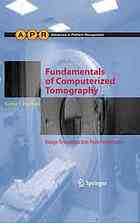

Most ebook files are in PDF format, so you can easily read them using various software such as Foxit Reader or directly on the Google Chrome browser.
Some ebook files are released by publishers in other formats such as .awz, .mobi, .epub, .fb2, etc. You may need to install specific software to read these formats on mobile/PC, such as Calibre.
Please read the tutorial at this link: https://ebookbell.com/faq
We offer FREE conversion to the popular formats you request; however, this may take some time. Therefore, right after payment, please email us, and we will try to provide the service as quickly as possible.
For some exceptional file formats or broken links (if any), please refrain from opening any disputes. Instead, email us first, and we will try to assist within a maximum of 6 hours.
EbookBell Team

0.0
0 reviewsComputerized tomography, the process of obtaining the density distribution within a human body from multiple x-ray projections, has revolutionized diagnostic radiology over the past three decades. Fundamentally the same computational process has been used for reconstruction from projections in many other fields of science, engineering and medicine; for example, for the reconstruction of biological macromolecules from electron micrographs.
This thoroughly revised and fully updated text/reference presents the computational and mathematical procedures underlying data collection, image reconstruction, and image display in computerized tomography. Focused on the needs of the practitioner, with emphasis on reconstruction methods, the book carefully discusses points of implementation and application.
Following the successful formula of the widely cited first edition, the book investigates the field of computerized tomography in detail, summarizing the diverse applications of the technique. Further chapters concentrate on reconstruction algorithms, followed by a treatment of the 3D display of the results and a final chapter with proofs of the fundamental mathematical theorems.
Some entirely new topics are introduced; these include the fast calculation of a ray sum for a digitized picture, the task-oriented comparison of reconstruction algorithm performance, blob basis functions and the linogram method for image reconstruction.
Topics and features:
*Describes how projection data are obtained and the resulting reconstructions are used in science and medicine, focusing on x-ray data but also covering other fields such as electron microscopy, nuclear medicine, ultrasound, materials science and nondestructive testing
*Presents a comparative evaluation of reconstruction methods, their accuracy under ideal and realistic circumstances, computational costs, task-oriented performance, and general applicability
*Provides a useful general syllabus for introductory courses
*Investigates reconstruction algorithms, including filtered backprojection, Fourier and linogram reconstruction methods, algebraic reconstruction techniques, and quadratic optimization
*Explores basis functions, functions to be optimized, norms, generalized inverses, least squares solutions, and maximum entropy solutions, as well as most likely estimates
*Discusses the design and application of a large programming system (SNARK09) for image reconstruction, as well as computerized methods for 3D surface detection and display
*Concludes each chapter with helpful Notes and References sections
This easy-to-read text/reference is an excellent guide for practitioners from a range of disciplines across science, engineering, and medicine. Based on three decades of the author’s teaching, it can also serve as a textbook for an introductory graduate course on image reconstruction.